I think regular readers will have worked out that there were some obvious reasons I saw textiles everywhere in Japan–after all, I was seeking them out! I must admit though–and I’ve already explained that my ignorance and lack of language are a limitation–that fabric in Kyoto seemed far more accessible than at home. I was really impressed by the range of scrap fabric and recycled fabric available, and the range of places it was for sale. My friend and I bought scrap packs at a high end Shibori store. There were packs of scrap fabrics available on street stalls during the evening street parties that came with the Gion festival. Kimono is a big business in Kyoto and no doubt especially during the Gion festival, when people clearly go out of their way to dress up and dress traditionally, and tourists often do so as well.
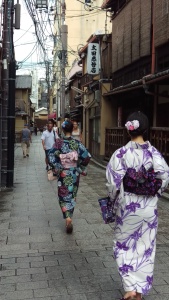
This may be one reason that secondhand kimono are for sale in so many places. The amount of silk made into clothing in Japan (relative to Australia) might also account for the availability of bolt ends of kimono silk and for some of the scraps which seem to have been torn off when a hem was raised, for example. But to my ignorant eyes it also seemed there was a different kind of reverence for beautiful fabric and design. During the Gion festival when community treasures are on display, fabulous garments were among them.
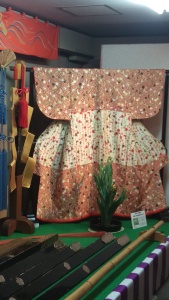
When the Gion floats were paraded through the streets, they were hung with amazing, and in some cases, ancient, tapestries and carpets, often imported (long ago and from far away).

Here is another example.
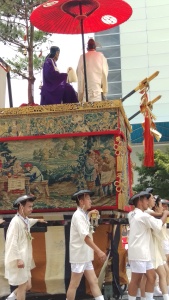
And another! It was amazing! I had been watching some of the floats being assembled out on the streets (remember the temperature is 39C or above every day at this stage), visited them on display once complete and seen the Gion Bayashi musicians rehearsing in them. Then we saw them lifted, pulled or wheeled through the streets on one of the two parade days. To see them all was extraordinary–each with a complex history and a heavy freight of symbols. How hard it must have been to be pulling them through the streets–some of them weighing tonnes and with antique wooden wheels, being kept on track by a wooden chock dextrously applied as the wheels turned, and cornering without steering by use of wet bamboo slats and brute strength. Sweaty work even for the very committed.

But wait, there’s more. I’d researched some things prior to departure and understood Nomura Tailor was not to be missed. The main store was on the big shopping strip of Kyoto (the Rundle Mall of Kyoto for local-to-me readers). It looks small here but there were four, or perhaps five, floors!
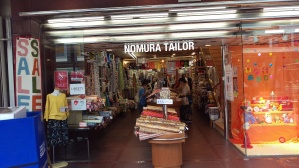
I was entirely unsure whether it was acceptable to take photographs, and found myself in someone’s way no matter where I stood on any floor with a small reprieve on the top floor where haberdashery was for sale. I was utterly embarrassed!
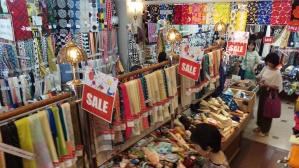
Here was for sale every kind of cloth. Every colour of linen. Lots of cute prints (I now understand a little more about the cute aesthetic in Japan, but not a whole lot)! In the image above you can see an entire display of Marimekko. I have never seen so many Liberty prints outside a Liberty store. And so on (remember, this is only what I could recognise). It was overwhelming. I try not to buy new stuff as a general rule–but I really wanted to buy here and could find no way to make a decision about where I would stop if I started. I came back on a second day to see if I had more judgment or perhaps it was less crowded. I still could not bring myself to buy fabric, overwhelmed by how I would ask for it, not understanding how to initiate a purchase, not wanting to hold up the queue, and in general feeling all heffalump in a very organised and efficient space in which I was unable to grasp the key organisational and efficiency principles. I bought some braid, some Japanese zippers and some sashiko sampler packs. The difference between buying fixed items and negotiating yardage is profound, or at least it felt that way to me on the day!
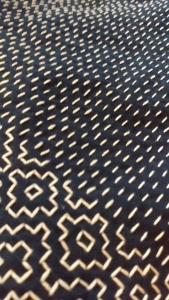
The sashiko samplers turned out to be cushion covers but only the shape of the fabric and the pictures with the Japanese instructions inside allowed me to work this out. I became ill a week or so after returning and did a lot of stitching!
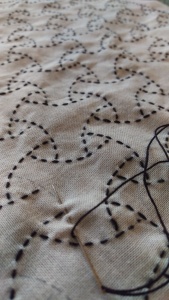
None of these was the highlight for me. The highlight really was going to a shrine sale the day we left. We went to the flea market, and it was immense. It was not a fabric sale–pottery, tools, metal, ready to eat food, brushware, vegetables, pickles… just abut everything! It was over 40C that day and I inhabited a fantasy that I could look around and come back to things sighted earlier. Oops! That is one thing I do regret. Here was every kind of fabric, new and second hand. New garments and second hand garments. Second hand sake bags.

Sacking, advertising materials on fabric (as far as I could tell). Cheap mass produced stuff. I bought what turned out to be strips from the ends of bolts (lengths?) of white silk kimono fabric. Then there were so many second hand fabrics whose origins I could only guess.
There were plant dyed clothes, and while indigo was prominent some were dyed with nettles, cedar bark or wormwood (that is what I could understand at any rate–)
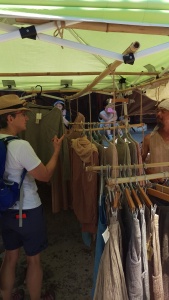
There was vintage clothing and fabric in every stage from well preserved to utterly disintegrating and in every stage of being mended from a patch here or there to rags stitched together–the boro tradition. There were also many stallholders converting scraps of beautiful silk or vintage indigo dyed fabric into small items of loveliness, honouring them by transforming them.
I have read about boro and seen images, and read its history. But while some of these items spoke of thrift and long wear, some were so ragged and so much mended that I was confronted by a sense of grief and awe for the people whose suffering and resilience created these clothes and cloths. While they now sell for a good deal of money (which does not go to anyone who used them), these items speak of the sheer poverty and difficult lives as well as speaking of the diligence, skill, love and care that must have gone into them.
In the end, I felt as though the flea market was an education in the life of everyday people through textiles. The museums I visited focused on things of high quality and amazing craft and design skill (as museums often do). Yet, this means museums often tell the stories of the wealthy and powerful, even when it is their clothing that is on show. At the flea market, the incredible effort that went into staying warm and covered for so many people who made that wealth possible was on show instead.








How absolutely mouth wateringly wonderful! I love fabric.
LikeLiked by 1 person
Oh, Mag, it truly was! As must be obvious, I love fabric too 🙂
LikeLike
Nothing I have read has ever made me long to return to Kyoto as much as reading this article …. I don’t think I ever will return, but I have so enjoyed reading it – thank you!
LikeLiked by 1 person
Such an extraordinary place! I hope I can return one day.
LikeLike
I loooove Nomura tailors, Kyoto is changing a lot now and there used to be a smaller one in Tera machi that disappeared this year so I hope it’s staying. I went to both markets the 21st (Toji) and the 25th (Kita no Tenmangu) and saw some boro and some flags ( both quite expensive). It’s such a joy to buy cloth in Japan. Tokyo has a lot of nice shops too.
LikeLiked by 1 person
Thanks Mchan! I failed to find the smaller Nomura Tailor and now I know why. Love those shrine sales!
LikeLiked by 1 person